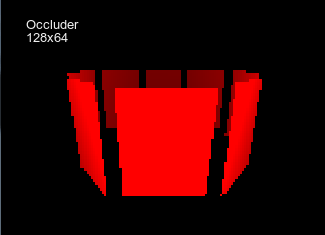Occluder
Occluder is an object that is used to cull objects' surfaces, bounds of which are not visible behind it.
- Mesh Clutter cannot be culled by an Occluder.
- Occluder culls objects conservatively (it hides only the objects that are definitely hidden by the occluder).
- Precision of occluders depends on their resolution. If the Occluder's resolution is insufficient, the culled object may become visible.
- Objects are culled based on their bounds.
Occluder can be highly effective in case of complex environments where there are many objects that occlude each other and are costly to render (they have a lot of polygons and/or heavy shaders).
However, effective culling is possible only if objects are not too large. If objects are big and have several surfaces, it is likely that an additional performance load of an Occluder will not pay off.
Occluder is rendered by the CPU and stored in a separate buffer. Only the Occluder nodes that are displayed in the viewport are saved to the buffer.
To display the buffer, you should pass 1 to the render_show_occluder console command:
render_show_occluder 1The buffer will open in the upper left corner:

Types of Occluder#
There are two types of Occluder:
-
 Occluder — a simple cuboid shaped Occluder
Occluder — a simple cuboid shaped Occluder
-
 Occluder Mesh — Occluder based on an arbitrary .mesh file
Occluder Mesh — Occluder based on an arbitrary .mesh file
The information on this page is valid for UNIGINE 2.19 SDK.